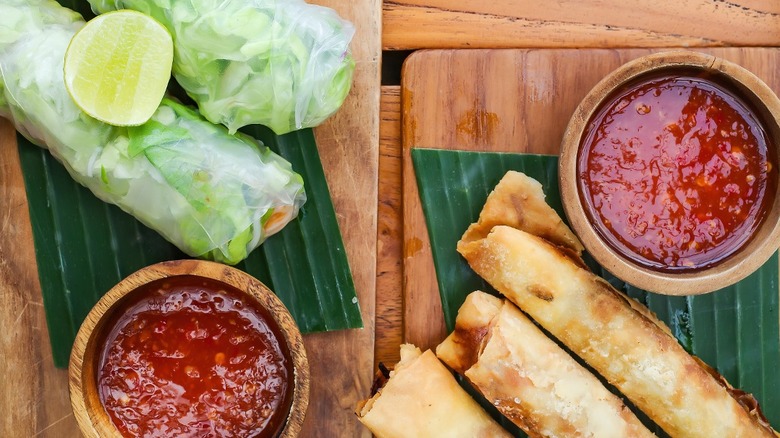The Wrapper Is What Separates Spring From Egg Rolls
Egg rolls and spring rolls both bring crunchy textures and flavorful dipping sauces to mind. The popular stuffed appetizer is synonymous with Asian cuisine, and the words "spring" and "egg" are often used interchangeably before "rolls" when describing it. However, one crucial distinction between egg rolls and spring rolls — their wrapping — makes the two dishes more different than you may imagine. The two wrapped foods are worlds (or at least countries) apart from their thickness and texture to their appearance.
Interestingly, you can find a clue to their differences in the names. Originating in ancient China, spring rolls were named after the seasonal spring vegetables eaten during the namesake season. These vegetables were initially eaten in pancakes, but spring rolls are now generally wrapped in rice paper. On the other hand, egg roll is a Chinese-American dish originating in the early 20th century wrapped in wheat flour dough and possibly draws its name from the eggs used to make the dough. There is also speculation that the original egg rolls used a thin omelet to wrap around the stuffing, which inspired the name.
In either case, spring and egg rolls continue to coexist, offering a versatile base for stuffing options and open to various dipping sauce options. Similar Vietnamese and Thai versions, generally made using rice paper, can be fried, steamed, or eaten cold in their delicate coverings.
Egg rolls have thicker dough wrappers
The original egg rolls were seemingly made by rolling the filling in sheets made of the same dough used to make wanton wrappers. This results in a thicker, more substantial roll that's crispy on the outside with thin, doughy layers on the inside. The dish was conceived by Chinese immigrants in the United States, recreating traditional spring rolls that hold symbolic meaning, much like dumplings during Chinese New Year. Since the spring celebration is a time of wishing for prosperity, spring rolls are likened to gold bars. A fun stateside spin on tradition is Thanksgiving-inspired egg rolls.
Unlike their American counterparts, traditional spring rolls are made by rolling ingredients in translucent rehydrated rice paper. They are narrower and more delicate, with a flaky crunch in fried versions. The rice paper rolls can also be steamed or eaten cold after only rehydrating, which you may know as Vietnamese summer rolls, while the dough-covered egg rolls are always fried. Interestingly, the spring pancakes of ancient China, from which spring rolls evolved, initially used wheat flour, but spring rolls now use wheat or rice flour for wrapping, with the latter being more popular in the form of rice paper.
In addition to their difference in size, spring and egg rolls are easily distinguished by their outer textures. The former has a smooth surface, while the latter is bumpy due to tiny air bubbles that form in the crispy dough while deep frying.
The wrapper influences filling and dipping sauce combinations
Because of their versatility, spring rolls are popular worldwide; several Asian countries have their own versions. In addition to the original Chinese spring roll, the American-Chinese egg roll, and the Vietnamese summer roll, there are Thai, Japanese (Harumaki), Cambodian, and Filipino (Lumpia) spring rolls. As you may imagine, the fillings are equally varied but generally contain a combination of vegetables, herbs, and protein.
Egg rolls are generally stuffed with ingredients that are already cooked and seasoned. Cabbage, carrots, mushrooms, and pork are all common. The thicker wrapper also means that the filling is more "aggressively" flavored, and egg rolls tend to be served with spicier sauces. While nothing stops one from using the same stuffing in a spring roll, the delicate rice paper is better paired with lighter flavors. In particular, steamed and raw spring rolls are stuffed with fresh and pickled vegetables, herbs, and rice vermicelli. Fresh whole shrimp is also a common spring roll filling, while vegan versions use flavorful marinated tofu.
Dipping sauces are as varied as fillings, and it's interesting to note that the difference in wrapping also affects how spring rolls and egg rolls interact with sauces. Smooth rice paper doesn't adhere too well to sauces, which is just as well since the delicate flavors require only a touch of strong flavoring liquid. Egg rolls, with their bumpy surface and doughy insides, are better at soaking up sauces, which adds to their hearty bite.


